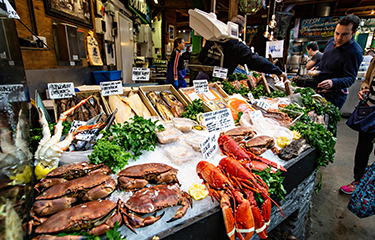UK retail seafood sales top GBP 4 billion, spurred by COVID-19 consumption shifts

Helped by the temporary closure of the restaurant and catering sectors during the coronavirus lockdown, the overall volume, value, and number of seafood products sold by U.K. grocery chains increased dramatically over the past year – with particularly strong growth seen in both the frozen and ambient retail categories.
According to the latest Nielsen ScanTrack data published by trade body Seafish, U.K. shoppers bought more than GBP 4 billion (USD 5.1 billion, EUR 4.4 billion) worth of seafood in the period between 12 June 2019 and 2020, representing a rise of 4.6 percent year-on-year. At the same time, the volume of products bought climbed 5 percent to 412,267 metric tons (MT), and the number of units sold increased by 4.6 percent to more than 1.5 billion.
Over the course of the 52 weeks, the average price paid for all seafood items was unchanged at GBP 2.60 (USD 3.28, EUR 2.89) per unit, while the average price per kilogram slipped to GBP 9.71 (USD 12.26, EUR 10.71).
According to these latest retail sales figures, chilled seafood, which accounted for 59.6 percent of total purchases, experienced a 0.8 percent decrease in sales value, falling to GBP 2.39 billion (USD 3 billion, EUR 2.6 billion). Going the other way, frozen sales increased by 11.1 percent to more than GBP 1 billion (USD 1.3 billion, EUR 1.1 billion), while the value of the ambient category grew 10.3 percent to GBP 604.3 million (USD 763 million, EUR 666.9 million).
The volume of chilled sales increased by 2 percent to 182,199 MT, while the number of units sold lifted 2.2 percent to 758.1 million (USD 957.2 million, EUR 836.6 million). The average price paid across the category was GBP 13.10 (USD 16.54, EUR 14.46) per kilogram and GBP 3.15 (USD 3.98, EUR 3.48) per unit, down by 1.2 percent and 1.4 percent respectively.
At the same time, the volume sold in frozen was up 5.9 percent to 139,028 MT and the number of units purchased increased 7 percent to than 386 million, while the ambient volume rose 10 percent to 91,039 MT and the number of units sold increased by 7.1 percent to 392.5 million.
Average frozen seafood prices for the 12 months increased by 4.9 percent to GBP 7.27 (USD 9.18, EUR 8.02) per kilogram, and by 3.9 percent to GBP 2.62 (USD 3.31, EUR 2.89) per unit. Ambient seafood prices increased by 0.2 percent per kilogram to GBP 6.64 (USD 8.38, EUR 7.32), and by 3 percent to GBP 1.54 (USD 1.94, EUR 1.70) per unit.
Frozen and ambient sales accounted for 25.3 percent and 15.1 percent of the U.K. retail market value, respectively.
In terms of the species sold over the 12-month period, the U.K. retail market continued to be led by salmon with sales approaching GBP 1.1 billion (USD 1.4 billion, EUR 1.2 billion), up 3.8 percent year-on-year. In volume terms, sales increased by 5 percent to 66,062 MT, and unit sales were 4.7 percent higher at 292.3 million (USD 369.2 million, EUR 322.6 million).
Cod and tuna followed with sales values of GBP 506.5 million (USD 639.7 million, EUR 559 million) and GBP 448 million (USD 565.8 million, EUR 494.5 million), rising 4 percent and 9.4 percent, respectively.
Average salmon prices were 1.2 percent lower year-on-year at GBP 16.85 (USD 21.28, EUR 18.60) per kg, while cod was up 2.6 percent to GBP 8.29 (USD 10.47, EUR 9.15), and tuna fell by 2.2 percent to GBP 6.60 (USD 8.34, EUR 7.28).
The largest sales growth was seen with eighth-placed pollock, with U.K. shoppers buying 33,780 MT of the fish, an increase of 7.7 percent – or 88.7 million units, an increase of 9.1 percent. This generated a total sales value of GBP 171.7 million (USD 216.8 million, EUR 189.5 million), which was 15.9 percent more than in the previous 12 months.
A strong upturn was also seen with 12th-placed pangasius, with 9,042 MT sold, an increase of 22.9 percent – which totals a roughly 16.9 percent increase of units sold to 27.7 million units. That bump in sales generated a 19 percent increase in revenues, which totaled GBP 69.8 million (USD 88.2 million, EUR 77 million).
The analysis also identified that the largest decline in sales was with crab products. The volume fell by 28.5 percent to 1,003 MT, and the number of units sold dropped 22.6 percent to 6,188 MT. Crab sales for the 12 months totaled GBP 23 million (USD 29 million, EUR 25.4 million), down 14.8 percent year-on-year.
With 20.8 percent of the total sales value, Tesco remained the country’s leading seafood retailer, followed by Sainsbury’s with 14.3 percent and Aldi with 12.7 percent. Aldi, Lidl and Co-op were the only chains in the top 12 to grow market share over the 12-month period.
Photo courtesy of Sun_Shine/Shutterstock






Share